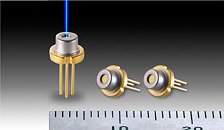malware
New Member
- Joined
- Nov 7, 2004
- Messages
- 5,422 (0.74/day)
- Location
- Bulgaria
| Processor | Intel Core 2 Quad Q6600 G0 VID: 1.2125 |
|---|---|
| Motherboard | GIGABYTE GA-P35-DS3P rev.2.0 |
| Cooling | Thermalright Ultra-120 eXtreme + Noctua NF-S12 Fan |
| Memory | 4x1 GB PQI DDR2 PC2-6400 |
| Video Card(s) | Colorful iGame Radeon HD 4890 1 GB GDDR5 |
| Storage | 2x 500 GB Seagate Barracuda 7200.11 32 MB RAID0 |
| Display(s) | BenQ G2400W 24-inch WideScreen LCD |
| Case | Cooler Master COSMOS RC-1000 (sold), Cooler Master HAF-932 (delivered) |
| Audio Device(s) | Creative X-Fi XtremeMusic + Logitech Z-5500 Digital THX |
| Power Supply | Chieftec CFT-1000G-DF 1kW |
| Software | Laptop: Lenovo 3000 N200 C2DT2310/3GB/120GB/GF7300/15.4"/Razer |
Sanyo Electric Co. said on Monday that it has created a new blue-violet semiconductor laser that might hold the key to the future of Blu-ray. According to the information given by the company, this laser can emit a beam of 450 milliwatts, which is about double the power of Sanyo's current highest-power laser for Blu-ray Disc systems. The higher power means it can write and read data on discs with up to four data layers and at speeds of up to 12X, Sanyo said. Each recording layer on a Blu-ray Disc can store 25GB of data, and the highest-capacity commercial discs currently have two recording layers. A four-layer disc would be able to hold 100GB of data, enough to store up to eight hours of 1080p video content. At 12x recording speed writing a four layer 100GB Blu-ray disc will take just around 10 minutes. That's the good part, unfortunately approving the 12x laser from the Blu-ray Disc Association and putting it into mass production can take two or even three years.

View at TechPowerUp Main Site

View at TechPowerUp Main Site





